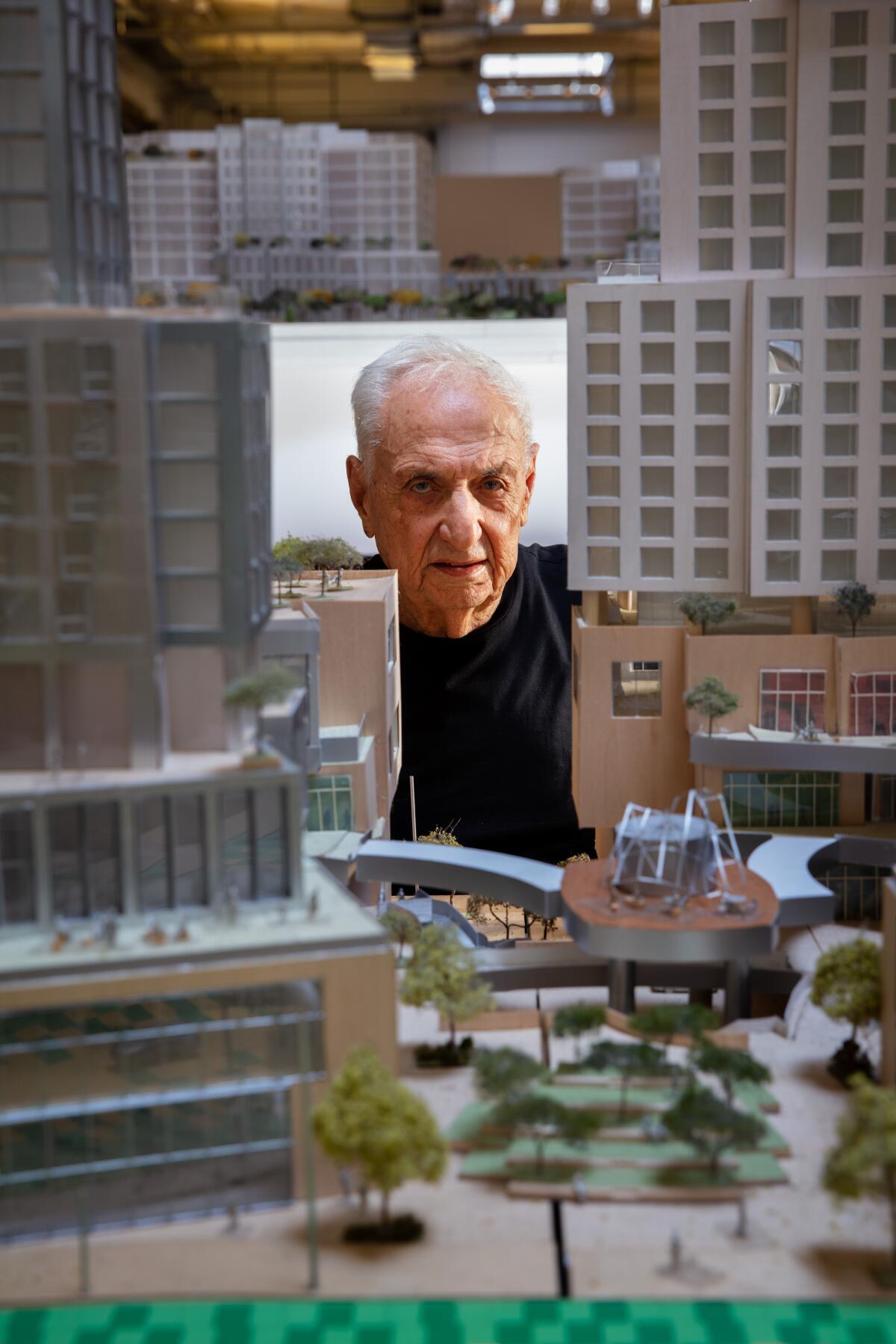Essential Arts: The Chicano Moratorium, a catalytic moment 50 years ago today
- Share via
A pivotal day of protest that 50 years later feels just as urgent. Frank Gehry’s Grand plans. Plus, an East L.A. telenovela and a little Hjørdis needlepoint. I’m Times arts and entertainment editor Laurie Ochoa, and with Carolina Miranda on vacation, I’ll be your guide to this week’s essential arts and culture news.
Essential image
Just as I was finishing this newsletter on Friday evening came the news that Chadwick Boseman died too young at 43 from colon cancer. My colleagues are in the process of writing appreciations for his brilliant career, but I immediately thought of this image he made with Times photographer Jay L. Clendenin. Not every star is as game to make such a vital portrait.

The Chicano Moratorium effect
On a Saturday morning 50 years ago today, at least 20,000 people came out to march on the streets of East L.A. for the National Chicano Moratorium Against the Vietnam War. But as Times reporter Louis Sahagun describes in his riveting narrative of the day’s events for a multi-part L.A. Times project, what started in peaceful protest ended in tragedy when Times columnist and KMEX TV news director Ruben Salazar was killed by a tear gas canister fired by an L.A. sheriff’s deputy. Two others, Lynn Ward, just 15, and Angel Diaz would die of injuries they received that day, and some 200 were arrested. The effects of the Moratorium reached beyond the violence.
Make the most of L.A.
Get our guide to events and happenings in the SoCal arts scene. In your inbox every Monday and Friday morning.
You may occasionally receive promotional content from the Los Angeles Times.
Times writer Daniel Hernandez talks with members of the Moratorium generation, including artist Harry Gamboa Jr. and politicians Gloria Molina and Carmen Ramirez, who were changed by the events of the day. Dorany Pineda gives us an insightful look at how Salazar the man became Salazar the icon, memorialized in murals, school and park names, songs, postage stamps, paintings and theater productions. There are recollections from Dodgers announcer Jaime Jarrín, who talks with Kevin Baxter about what he saw that day, plus Brittny Mejia finds out how the Moratorium looked to a 21-year-old Mexican American soldier named Tomás Sandoval, who found out about the protest when he was in Vietnam.
And Carolina Miranda examines how the Moratorium influenced artists such as Rupert Garcia, Judy Baca, Judithe Hernandez, the art collective Asco and even how East L.A.’s Self Help Graphics affected the way we celebrate the Day of the Dead.
Vanessa Martínez and Julia Barajas tell a fascinating story about the women who broke away from the Brown Berets to form their own Chicana group, Las Adelitas de Aztlán; Gustavo Arellano writes about his experience reading the writing of Ruben Salazar; and Ben Welsh collected Salazar’s columns from 1970, the year he died. Daniel Hernandez interviews filmmaker Phillip Rodriguez about his documentaries “Ruben Salazar: Man in the Middle” and “The Rise and Fall of the Brown Buffalo,” about the lawyer Oscar “Zeta” Acosta, who was the inspiration of Hunter S. Thompson‘s character Dr. Gonzo.
But the story that you could say was years in the making is the report by former Times investigative journalist Robert J. Lopez, who in 1994 was the first person at the paper to file a Freedom of Information Act request to the FBI on the mysterious and underreported circumstances of Salazar’s killing. It set him off on a quest for answers that he tells like a suspense thriller that doesn’t spare this paper’s culpability.

So how is Los Angeles commemorating such a crucial day for the city? With two different socially distant marches, a car caravan, a theater performance, a virtual screening and discussion of “Ruben Salazar: Man in the Middle” featuring opening remarks by Mayor Eric Garcetti. Get all the details here.
And about that East L.A. telenovela: Earlier this week the UCLA Film & Television Archive presented a virtual screening series and discussion of the Chicano Moratorium moderated by Chon Noriega, director of the UCLA Chicano Studies Research Center with artist Harry Gamboa Jr. and our own Carolina Miranda. I was most intrigued by the showing of “Canción de la Raza” (“Song of the People”), an English-language telenovela that aired on KCET in October of 1968. It centered on a fictional East L.A. family and was surprisingly political. The debut episode focused on the real-life March 1968 student walkouts or “blowouts” and what happened when police beat one of the sons. The screening is still viewable on Vimeo.
You can also watch the excellent L.A. Times forum on the Chicano Moratorium moderated by Column One editor Steve Padilla with Daniel Hernandez, Carolina Miranda and Robert J. Lopez.
Gehry’s Grand motivator
We all could use a reason to feel optimistic these days. When Times classical music critic Mark Swed caught up with Frank Gehry by Zoom just after the 91-year-old architect finished his daily mile-long swim, the two of them had a conversation that left me hopeful about downtown Los Angeles in a post-COVID world.
They talked about construction underway on the Grand, a Gehry-designed complex with housing, a hotel, movie theaters, restaurants and shops on the land that was once the “Tinker Toy” parking garage across the street from Disney Hall. But what was most interesting is Gehry’s proposal for a plaza that could be what Swed describes as “a kind of arts polis, a democratic gathering place for arts and ideas.... Imagine people spilling out of the Grand to concert halls, theaters, clubs, museums and the plaza, with an illuminated Disney as spectacular, cubist movie screen lighting up the sky with the concerts inside. No place in the world has such an indoor-outdoor arts epicenter. Nothing could be more in the L.A. character.”

Swed also gave us another wonderful installment of his How to Listen series, this time with an in-depth analysis of Schubert‘s last sonata, No. 21 in B-flat. He brings new understanding to a piece of music I know and love: “There are no trills like those in the first movement of the sublime piano sonata Schubert finished and performed two months before his death at 31.... How is it that so little to go on as a broken accompaniment of a simple melody, a quick little flick of a finger in the right hand on the last beat of most measures, inspires contemplation of the vast beyond?”

Coronavirus and the arts
Museums are starting to reopen in New York — at 25% capacity. On Thursday, the Museum of Modern Art reopened with the show “Félix Fénéon: The Anarchist and the Avant-Garde — From Signac to Matisse and Beyond” and new face mask rules. The Metropolitan Museum of Art opens to the public today with Héctor Zamora’s COVID-delayed “Lattice Detour” wall sculpture now viewable on the roof garden. The Whitney reopens to the public on Sept. 3 and the Museum of the City of New York and American Folk Art Museum are already open.
What about Southern California? Orange County’s Bowers Museum and L.A.’s Petersen Automotive Museum briefly reopened before shutdowns were reinstated in July after a rise in COVID-19 cases. But as The Times’ Deborah Vankin reports, the Natural History Museum of Los Angeles County is reopening its Butterfly Pavilion and some of its outdoor nature gardens this weekend for members, with just 10 people allowed in the pavilion at a time.
This comes after the Huntington Botanical Gardens opened with limited advance reservations earlier this summer. But if you haven’t been able to get a ticket, the Huntington has a live webcam keeping an eye on the infamous — and foul-smelling! — corpse flower, which is expected to bloom any day. A fitting activity for the times, because as Times writer Lisa Boone — and the Huntington and so many others — put it, “2020 stinks.”
And despite a shortened Broadway season halted on March 12 by COVID-19, the Tony Awards will take place digitally. No date or streaming platform has been announced yet. A statement from the Broadway League and the American Theatre Wing, producers of the Tonys, said, “Though unprecedented events cut the Broadway season short, it was a year full of extraordinary work that deserves to be recognized.”
Enjoying this newsletter? Consider subscribing to the Los Angeles Times
Your support helps us deliver the news that matters most. Become a subscriber.
Black Lives Matter mural for Hollywood
A portion of Hollywood Boulevard was closed this week so that a Los Angeles Bureau of Street Services-commissioned crew from Creative Paving Solutions could make a permanent mural of the message left by volunteers before a June 14 anti-racism march: All Black Lives Matter.
“This is the very first public space installation devoted to the Black queer community and transgender people of color,” City Councilman Mitch O’Farrell told Times reporter Anh Do. “It’s the right time, it’s about time, and when Hollywood speaks, the audience notices.”

In other news
— The Los Angeles Museum of the Holocaust is changing its name to Holocaust Museum Los Angeles. “This puts the Holocaust name first,” museum Chief Executive Beth Kean told Times reporter Deborah Vankin. That’s important, Kean added, not only “because of what’s happening right now in the Black Lives Matter movement and the rise in anti-Semitism,” but also “because a post [Holocaust] survivor world is right in front of us.... We need to amplify our impact and do better at educating.”
— Former Pasadena Playhouse artistic director Sheldon Epps is taking on a new role as senior artistic advisor for Ford’s Theatre in Washington, D.C., where President Abraham Lincoln was assassinated. The Times’ Jessica Gelt reports that the highly respected Epps will begin the job for the theater, operated in partnership with the National Park Service, from his Southern California home in Pasadena.
— Opera’s Plácido Domingo agreed to an interview with the Associated Press, which last year published an investigation into “ ‘inappropriate conduct’ with multiple women over a period of decades.” “I never promised a part to a singer, or never take a part from a singer,” the 79-year-old singer said. “I have spent my whole life helping, and you know, encouraging and driving people.” Domingo also talked about contracting COVID-19, which led to him being hospitalized for 10 days. He’s recovered enough to resume performing in Europe. He doesn’t anticipate being able to sing in the U.S. anytime in the future.
— Matt Cooper has 17 picks for weekend culture events, from a live reading of “The Ballad of Emmett Till” to the Laguna Playhouse Annual Gala with Tony Shalhoub, Joe Mantegna and Alfred Molina.
And last but not least ...
In honor of my current COVID-time binge of the fifth and final season of the Danish TV series “Rita,” released this month on Netflix, I’ll leave you with an awkward needlepoint image of open-hearted, cosplaying, pattern-mixing Hjørdis (Lise Baastrup), fiercely loyal friend to Mille Dinesen‘s subversive teacher Rita. Showtime is in the process of making an American version of the show with Game of Thrones’ Lena Headey — here’s hoping the new “Rita” has a Hjørdis.
The biggest entertainment stories
Get our big stories about Hollywood, film, television, music, arts, culture and more right in your inbox as soon as they publish.
You may occasionally receive promotional content from the Los Angeles Times.




